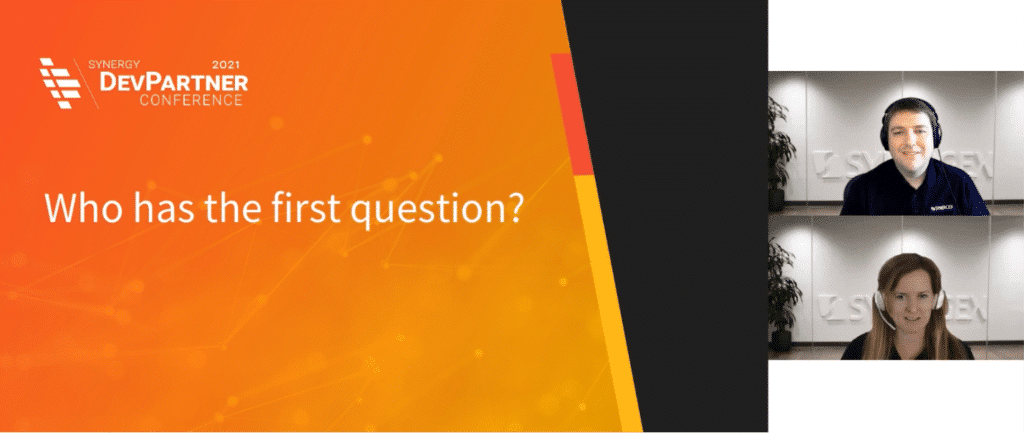March 2020. We were three months away from the Synergy DevPartner Conference, an in-person learning event we hold for our customers every 18 months. Then the pandemic hit and upended everything. We had no idea that within a year, we’d have to completely reconceptualize and adapt our entire conference blueprint for a virtual audience while providing the same educational value and keeping the communal spirit of our in-person gatherings.
In the end, we were able to present 16 content-packed virtual sessions to a record number of attendees that, thanks to a boatload of planning and persistence, went off with barely a hitch. (You can watch most of the conference sessions here.)

Here’s how we did it.
Planning
Planning any large event is a significant logistical undertaking, requiring coordination and cooperation between multiple departments. The more you plan ahead, the less you have to panic at conference time. We won’t bore you with every detail of our particular planning process, but here are some foundational steps we took to make sure all our bases were covered.
What we did:
- Held weekly conference check-ins. Communication is key for making sure nothing falls through the cracks.
- Created standard branding. The conference had its own “look” that was used to design the website, PowerPoint templates, webinar rooms, session landing pages, etc., to ensure a cohesive aesthetic that distinguished it from our usual content.
- Got organized. Whether it was shared spreadsheets, Kanban boards, etc., we made sure the key players had insight into the necessary tasks and timelines, so no one was in the dark.
- Allowed time to work on “nice-to-haves” (informal networking sessions, giveaways, etc.) in addition to the necessary components of the conference. Sometimes it’s the little things that make an event special.
Additional Takeaway: Hold a pre-mortem. A pre-mortem is a thought experiment that encourages people to think about what could go wrong. A few members of the conference planning committee got together in April and did some brainstorming about specific issues that could arise during the conference. For example, we determined who would step in as moderator if either of our two main MCs called in sick. Or, if the Q&A portion of a session went on for longer than expected, we came up with a solution: unanswered questions would be collected and answered during the wrap-up session. Thankfully, no one wound up getting sick, but it was comforting to know we had a plan in case that did happen.
Execution
While planning is nine-tenths of the game, you still have to execute. The following are some things to keep in mind so everything goes smoothly when the time comes.
What we did:
- Created a task force to handle registrant issues that communicated frequently. Because we had additional people on hand to field customer support, the organizers were free to focus on making the conference happen.
- Kept an eye on statistics. We sent analytics to our sales team after every session so they could reach out to customers accordingly.
Additional Takeaway: Talking to a camera instead of an audience is…weird. Pre-recording most of the sessions was helpful for a handful of reasons: it allowed presenters to take a substantial breather between slides (grab a cup of coffee, get the demo ready without rushing), and we had the opportunity to add some creative flourishes in post-production. Still, most presenters found the camera to be a poor substitute for a live audience. In the future, we’ll consider inviting additional staff to recordings to act as a stand-in audience.

Flexibility
Ultimately, you have to be nimble, ready to adapt to changing circumstances, and take on any challenges that pop up. Luckily, you can prepare for flexibility too.
What we did:
- Backups, backups, backups. For pre-recorded sessions, the main plan was to upload the files into the webinar platform and hit play. But we always had a backup plan in case something went wrong (private YouTube video versions of the sessions we could link to, etc.).
Additional Takeaway: You don’t need to use a one-size-fits-all formula for conference sessions. We had to work around several factors when recording the 16 sessions, including each presenter’s geographic location and level of comfort in a live vs. pre-recorded context. Rather than make everyone do everything the same way, we gave presenters flexibility in terms of how they wanted to structure and lead their sessions, and we wound up with a nice variety because of it.
We look forward to seeing you at the 2022 conference!
Check out the conference sessions and learn how to do the following:
- Improve development productivity and practices through adopting more efficient development methodologies.
- Enhance years of Synergy data and code with new technologies, enabling connectivity through RESTful web services and APIs.
- Keep up to date with Synergy SSL and operating system security patches. (Security and disaster recovery are important for compliance!)
- Use traditional Synergy in Visual Studio to gain a huge productivity boost, lower the barrier to continuous code integration, and improve processes and software quality.

